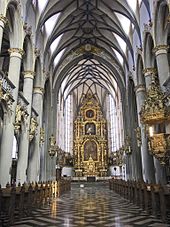Post-Gothic

As Nachgotik the occurrence is called Gothic architecture motifs in the epochs of Renaissance and the Baroque , ie after the actual medieval era of the Gothic .
main features
On the one hand, it is a continuation of the medieval building tradition (especially in vaulted construction) within the framework of craft and guild-style architecture, and on the other hand, the programmatic use of selected Gothic elements such as ribbed vaults and tracery windows in sacred buildings in contrast to secular building. The style is therefore rarely found on high-ranking secular buildings such as castles or town halls. Antique wall-related motifs such as columns and beams are systematically combined with the Gothic motifs .
distribution

The use of post-Gothic forms was particularly important in the Protestant countries for the construction of churches and chapels, for example in the form of the main church Beatae Mariae Virginis in Wolfenbüttel and the Bückeburg city church . Based on them, the sacred architecture of the Weser Baroque shows post- Gothic tendencies. The construction of important and representative secular buildings was rather rare, although post-Gothic solutions played a central role in the expansion of the English universities of Oxford and Cambridge until the late 17th century .
There were also post-Gothic forms in Catholic areas, for example in Franconia the so-called Echtergotik (an outdated term, also called Echterstil or Juliusstil ), which is associated with the Würzburg Prince-Bishop Julius Echter von Mespelbrunn . The most famous example is the pilgrimage church in Dettelbach . Post-Gothic principles were also often used in Jesuit church construction in some areas (outdated: so-called Jesuit Gothic): e.g. B. St. George and Trinity Church in Molsheim and St. Mary's Assumption in Cologne .
Post-Gothic tendencies can be found in Italian Baroque architecture in Guarino Guarini ; his posthumously published work Architettura Civile (1686) contains a clear commitment to Gothic , as is implemented in his San Lorenzo church in Turin . Building on him, Johann Blasius Santini-Aichl used Gothic elements in the Bohemian architecture of the late Baroque in the monastery churches of Sedlec and Kladruby and the pilgrimage church of Zelená Hora . The Teutonic Order Church in Vienna is a prime example of the Baroque post-Gothic style of the 18th century in Austria .
In France, various of the great cathedrals continued to be built in Gothic forms during the Baroque period or even started anew: for example, the new construction of the Orléans Cathedral, which began in 1601, and the construction of the Nantes Cathedral from 1627.
Post-Gothic and Neo-Gothic
Post-Gothic is the use of Gothic forms in the context of architecture (Renaissance, Baroque) that is fundamentally based on antiquity. The Gothic motifs are used here as a distinguishing feature, e.g. B. to give church buildings a sacred appearance. In contrast, the neo-Gothic is the new formation or re-creation of medieval architectural styles intended as units. In the epochs of Romanticism and Historicism , it was used to design churches, town halls, residential buildings and castles.
According to Hermann Hipp , the main difference on the stylistic level is that only selected motifs were used in the post-Gothic period. In Central Europe, for example, was largely based on the use of the Nachgotik spire and gable waived. In the neo-Gothic style, the original Gothic style elements are often used again.
literature
- Hermann Hipp : Studies on "Post-Gothic" of the 16th and 17th centuries in Germany, Bohemia, Austria and Switzerland. Three volumes. Hanover, 1979.
- Hermann Hipp: The Bückeburg "structura". Aspects of the post-Gothic in connection with the German Renaissance . In: Renaissance in North Central Europe I. (= Writings of the Weser Renaissance Museum, Brake Castle 4). Munich, Berlin 1990, pp. 159-170.
- Hermann Hipp: The "post-Gothic" in Germany - no style and no style . In: Hoppe, Stephan; Nussbaum, Norbert; Müller, Matthias (Hrsg.): Style as meaning in the north Alpine renaissance. Rediscovery of a methodical neighborhood. Regensburg 2008, pp. 14-46.
- Barbara Schock-Werner: The buildings in the prince-bishopric of Würzburg under Julius Echter von Mespelbrunn 1573-1617. Structure, organization, funding and artistic evaluation . Regensburg 2005.
- Michael Hesse: From post-Gothic to neo-Gothic. The examination of Gothic in French sacred architecture of the 17th and 18th centuries 18th century. Frankfurt am Main 1984.
- Ludger J. Sutthoff: Gothic in the Baroque. On the question of the continuity of style outside of its epoch . Dissertation, Saarbrücken 1988.
- Engelbert Kirschbaum: German post-Gothic, a contribution to the history of church architecture from 1550–1800. Augsburg 1930.
